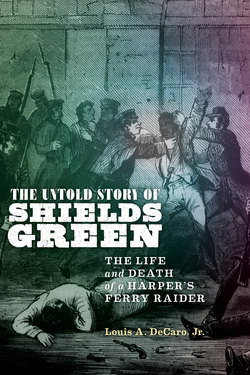The Untold Story of Shields Green

Реклама. ООО «ЛитРес», ИНН: 7719571260.
Оглавление
Louis A. Decaro Jr.. The Untold Story of Shields Green
The Untold Story of Shields Green. The Life and Death of a Harper’s Ferry Raider
Contents
Illustrations
Preface
1. Emperor Mysterious. To Find the Man Who Lived
2. Emperor Enlisted
3. Emperor among the “Invisibles” Maryland, 1859
4. The Raid and the Black Witness
5. Alias Emperor
6. Emperor Seen. Image and Identity
Epilogue. Legacy, Relic, Legend
Acknowledgments
Abbreviations
Notes. Preface
Chapter 1. Emperor Mysterious
Chapter 2. Emperor Enlisted
Chapter 3. Emperor among the “Invisibles”
Chapter 4. The Raid and the Black Witness
Chapter 5. Alias Emperor
Chapter 6. Emperor Seen
Epilogue
Selected Bibliography
Index
About the Author
Отрывок из книги
Also by Louis A. DeCaro, Jr.
On the Side of My People: A Religious Life of Malcolm X
.....
As Ira Berlin observed in his seminal work, Slaves without Masters, “Southern free Negroes balanced precariously between abject slavery, which they rejected, and full freedom which was denied them.”26 Berlin’s study, which highlights the differences between slavery in the Upper and Lower South, is useful in understanding Green’s original context. In South Carolina, like the rest of the Lower South, freemen lived in a tenuous position between whites and their enslaved black brethren, a position that “allowed them just enough room to create their own life under the hateful glare of whites and within the slave society.” Unless self-employed, free blacks often were obligated to hire themselves out to whites who exploited their labor and deducted expenses from their salaries, often ensnaring them in “perennial indebtedness.” If a free black man like Green had found himself either deeply in debt or involved in some other legal problem involving fines, taxes, or jail fees, he would have been imprisoned and possibly sold into virtual slavery without hope of relief or deliverance.27 Likewise, in his vital study Black Charlestonians, Bernard Powers Jr. affirms that, apart from the experience of the most elite free blacks, free persons of color in Charleston led an “imperiled” existence. Not only could they be legally sold into slavery due to the aforementioned financial and legal burdens that were imposed upon them, but sometimes they were also kidnapped and sold into slavery.28
According to an abolitionist who knew him after he had fled to the North, Green told her, “I have suffered cruel blows from men who said they owned me.”29 These words might just as likely have come from a freeman who had fallen prey to slavery’s grip than from one born into slavery. In the late antebellum era, free people of color in the South found themselves increasingly under assault as both previously unenforced laws and new laws were imposed upon them, restricting every aspect of black life.30 Free blacks convicted of crimes were punished more harshly; for failure to pay city taxes, for example, they were subject to extended periods of forced labor, whereas whites were issued fines. Charleston’s free black men between the ages of twenty-one and sixty had to pay a tax of ten dollars if they practiced any kind of trade or art in the city. Likewise, free black males between eighteen and fifty years of age were subjected to a poll tax of two dollars. If a free black man failed to pay this tax, he could be handed over to the sheriff, who was then authorized “to sell him for a period of service not more than five years, sufficient to pay the costs.”31 While enslaved people were routinely beaten, in the 1850s free blacks increasingly were also whipped for violations that whites were only fined for committing. As Leonard P. Curry concluded, free blacks now “lived between two worlds with an unsteady foot in each.”32
.....